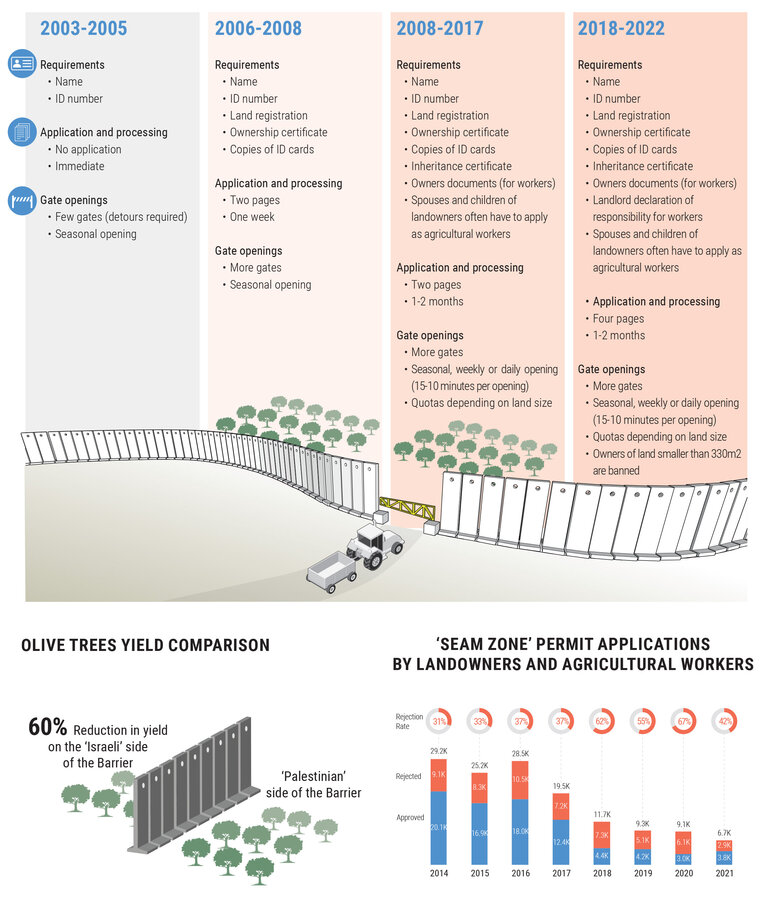The humanitarian impact of 20 years of the Barrier - December 2022
Key facts
- In 2002, the Israeli authorities started to build a Barrier with the stated aim of preventing violent attacks by Palestinians inside Israel. Most of the Barrier’s route is located within the West Bank, rather than on the 1949 Armistice ‘Green’ Line. The area between the Green Line and the Barrier is referred to as the ‘Seam Zone’.
- The Barrier is one element of a range of restrictions that Israel has imposed on Palestinians since 1967, which include physical obstacles, bureaucratic constraints such as permit requirements and the designation of areas as restricted or closed. The Barrier consists of concrete walls, fences, ditches, razor wire, sand paths, an electronic monitoring system, patrol roads, a buffer zone and several military checkpoints.
- The Barrier’s total length, constructed and projected, is 713 km, more than twice the length of the Green Line. About 65 per cent of the approved route is complete.
- Eighty-five per cent of the Barrier’s route runs inside the West Bank. If finished, as planned, it will isolate 9 per cent of the territory of the West Bank including East Jerusalem.
- Seventy-one Israeli settlements and over 85 per cent of the settler population, are in the ‘Seam Zone’.
- Approximately 150 Palestinian communities living in the rest of the West Bank have farmland located in the ‘Seam Zone’, forcing them to seek special permits or ‘prior coordination’ to access their crops and flocks.
- Farmers can only reach their land through 69 designated gates which are controlled by the Israeli authorities and are typically closed. Most agricultural gates only open during the October-November olive harvest for a limited time each day.
- Around 11,000 Palestinians living in the ‘Seam Zone’ and who hold West Bank ID cards also depend on the granting of permits or special arrangements to live in their own homes.
- Palestinians with West Bank ID cards require special permits from the Israeli authorities to enter East Jerusalem; they may do so through four of the 14 Barrier checkpoints.
- On 21 June 2022, ,following a series of attacks in Israel, the Israeli authorities began repairing and fortifying a 45-km stretch of the Barrier in the northern West Bank, replacing segments in that section, to prevent Palestinians entering Israel through unregulated openings.
Accessing farmland isolated by the barrier
- The vast majority of the Barrier’s route is located within the West Bank, separating Palestinian communities and farming land in the ‘Seam Zone’ from the rest of the West Bank and contributing to the fragmentation of the occupied Palestinian territory (OPT). The inclusion of Israeli settlements is the most important factor behind the decision by the Israeli government to deviate the Barrier’s route away from the Green Line and into the West Bank.
- In its 2004 Advisory Opinion, the International Court of Justice (ICJ) established that the sections of the Barrier which run inside the West Bank, including East Jerusalem, together with the associated permit and gate regime, violate Israel’s obligations under international law. The ICJ called on the Israeli authorities to cease the construction of the Barrier, dismantle the sections already completed, and repeal all legislative measures related to the Barrier.
- The Barrier blocks Palestinians living in the ‘Seam Zone’ from accessing their places of work and essential services in the rest of the West Bank. To continue living in their own homes and to maintain family and social relations with the rest of the West Bank they must obtain permits or ’prior coordination’, and pass through Barrier checkpoints. Access of service providers to these communities, including ambulances and fire brigades, is likewise impaired.
- Agriculture-based livelihoods of thousands of families have been undermined due to the gate-and-permit regime, which hinders farmers from accessing their farming and grazing lands in the ‘Seam Zone’. Permit applications are regularly rejected on grounds that farmers failed to prove their ’connection to the land‘ to the satisfaction of the Israeli authorities, as well as citing security concerns. The almost permanent closure of all agricultural gates, with limited exceptions, has forced permit-holders to stop cultivation or to shift from labour-intensive to rain-fed and lower-value crops.
- Between 2014 and 2021, the number of permits requested by landowners and agricultural workers dropped by 77 per cent. This drop is largely attributed to the high rejection rates of permit applications, cumbersome application procedures, the issuance of permits for short periods, and limited gate opening times amongst other factors. The limitations in accessing land has resulted in a 60 per cent reduction in yield in land beyond the barrier.
- The Barrier has transformed the geography, economy and social life of Palestinians living in East Jerusalem, as well as the lives of those residing in the wider metropolitan area. Neighbourhoods, suburbs and families have been divided from each other and separated from the urban centre, and rural communities have been separated from their land.











